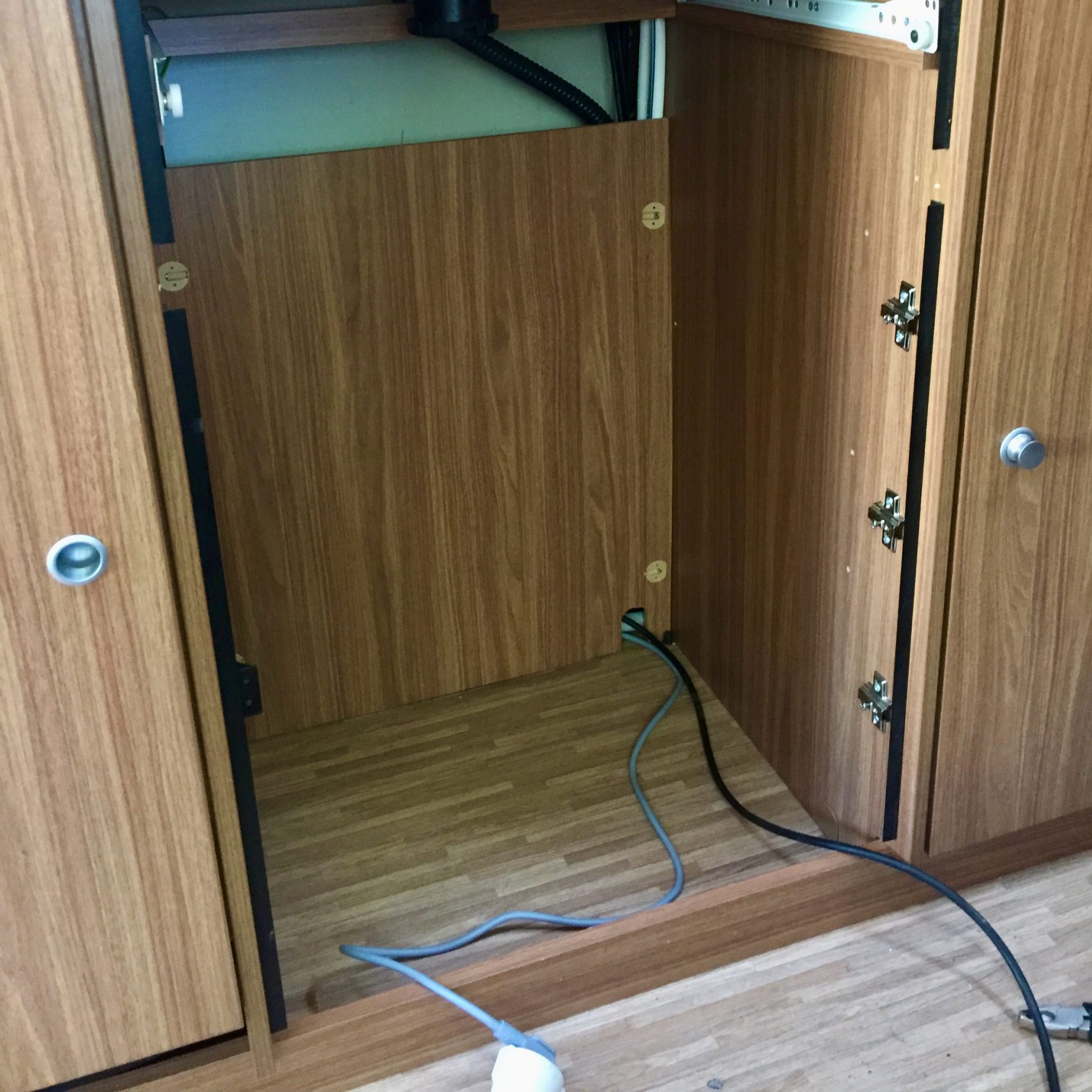Load the dishes, switch it on and end the evening relaxing with a glass of wine and a book
The washing-up dilemma
On all our motorhome trips with our children, we have noticed that the everyday activities are so seamlessly connected that there was hardly ever any time to relax. Especially the cooking and the washing up always took up a lot of time every day. It was particularly difficult to put the children to bed while one of us washed the dishes in the washrooms. Often, it was already dark, and often other campers complained that we had to do the dishes so late. If we left the dirty dishes under the car, the ants or a nocturnal fox would pounce on them. If we put the dishes up somewhere, the same fox would try to get them down, which would cause unwanted disturbance. If we put the uncleaned plates into the storage space, they would smell very unappetizing. The washing up problem quickly became an everyday dilemma on a mobile home holiday with the family.

Are there actually camper dishwashers available?
So, during the third day of washing up at a peaceful campsite in the Alentejo, the thought occurred to me that there might be a dishwasher for motorhomes after all, and I started looking for a mechanical solution to our washing up dilemma, more curiously than with conviction. I thought to myself that somebody would surely make special dishwashers for camper vans. But just ordering and installing a machine somewhere – it should not be that easy. Finally, I was drawn to this article: Dishwasher in a caravan – does it make sense? by Stephanie and Marcus from Munich, and then their own ideas and the experiences of others quickly came together to form a feasible plan.
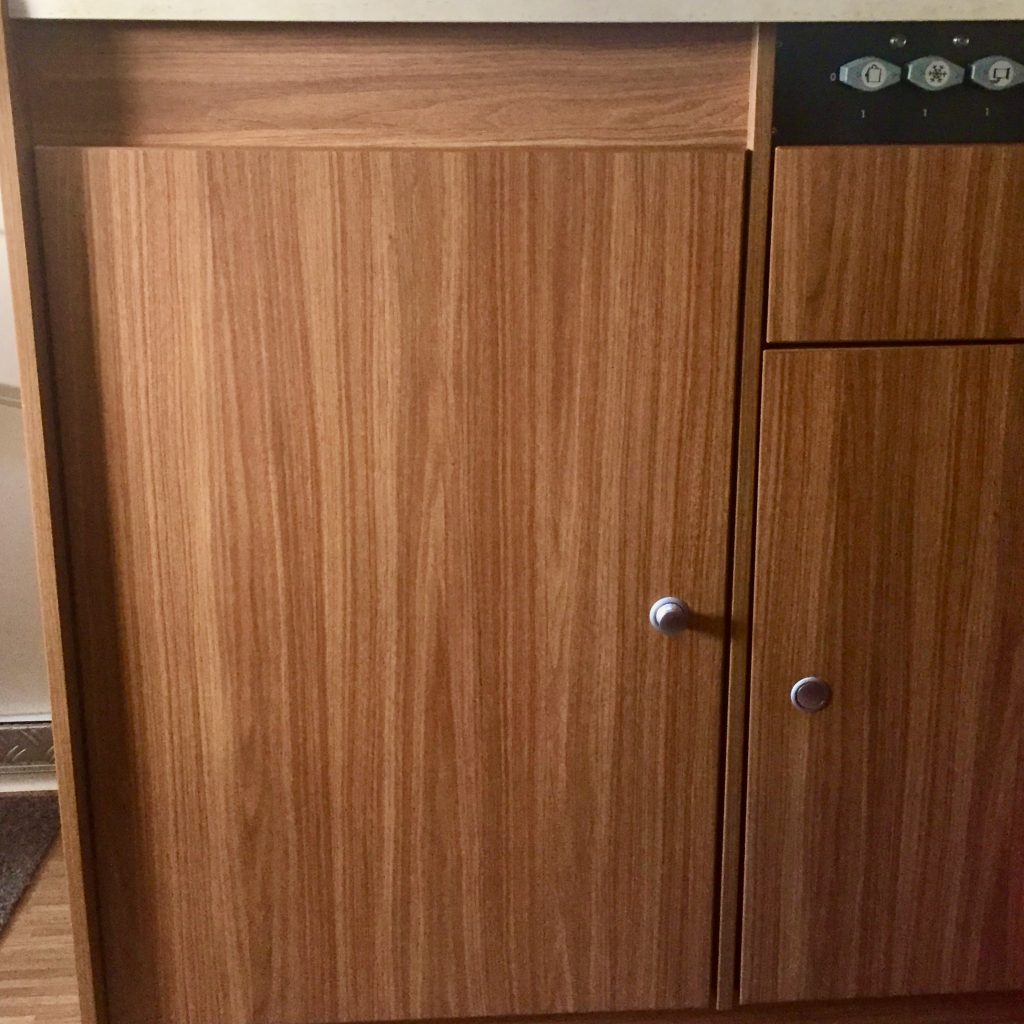
Where does the dishwasher fit in now?
Unfortunately, the dishwasher described in My Small House was not suitable for our motorhome. As much as I looked at every cupboard and did not want to shy away from extensive conversions, the required width of 60 cm simply could not be found anywhere, especially not near the kitchen. Unfortunately, there are no other dishwasher sizes on the market. Under the gas cooker in the kitchen area, however, there was a relatively large cupboard that we used rather thoughtlessly, and this actually offered enough space for a 45 cm-wide built-in dishwasher. In order to be able to install it there, however, some changes were still necessary. The heating system could be redirected by building a small box in the rear left corner so that no changes were visible on the outside. The cabinet door would just about fold down next to the seats, and only the table leg had to be moved a little.

The heater does not fit next to the dishwasher 
A small box provides a remedy 
The dishwasher door fits right next to the bench and in front of the table leg
The installation of the dishwasher
As for the dishwasher itself, we finally chose a 30 kg A++ dishwasher from Siemens, as this ensured that the water pump was activated when the inlet valve was opened. Surely an A+ model would have been sufficient, as the dishwasher is used comparatively rarely in motorhomes, but I had hoped that an A++ dishwasher would also have a low peak load. In order to keep the electricity consumption as low as possible, we connected the dishwasher to the hot water supply, even if this would have a negative effect on the cleaning quality of starchy bits. A relay, which is controlled by the inlet valve, could easily be placed in another damp-proof box behind the right-hand half of the cabinet and was connected to the switch on the kitchen tap. The 220 V connection was also quickly arranged from the moisture-proof connection box labelled 220 V. The installation of the machine itself was the only real adventure. Luckily, Siemens prepared small videos, which helped even a layman like me to work through the individual steps.

Hot water connection 
Relay for water pump control 
Sewage connection 
AquaStop with switch cable to relay 
Power supply of the dishwasher 
Siemens dishwasher 45 cm
Into the summer holiday without a test wash
A few days later, due to a lack of power supply near the caravan park, we went on our summer holiday without a final test run, and the first stop in Peniche with a 3 A fuse caused me to have some pretty painful doubts, because even the 40 degree glass programme failed after a short operation due to the deactivation of the circuit breakers. I had installed a 2000 W voltage transformer under the passenger seat, but even this could not continue the programme. These first doubts were dispelled when the dishwasher worked without problems at our next campsite, which had a 6 A fuse. Here, we could even do without warming up the water. And later, I also found a way to achieve a 40-minute rinse with 3 A. To do this, the refrigerator had to be switched to gas, and hot water had to be available. In addition, the remaining water from the last rinse before the rinse cycle had to be pumped out. And then we had to set the timer to 40 minutes so that we could switch off the dishwasher before the fuse was blown. A shortened second wash cycle could then remove the remaining soap.
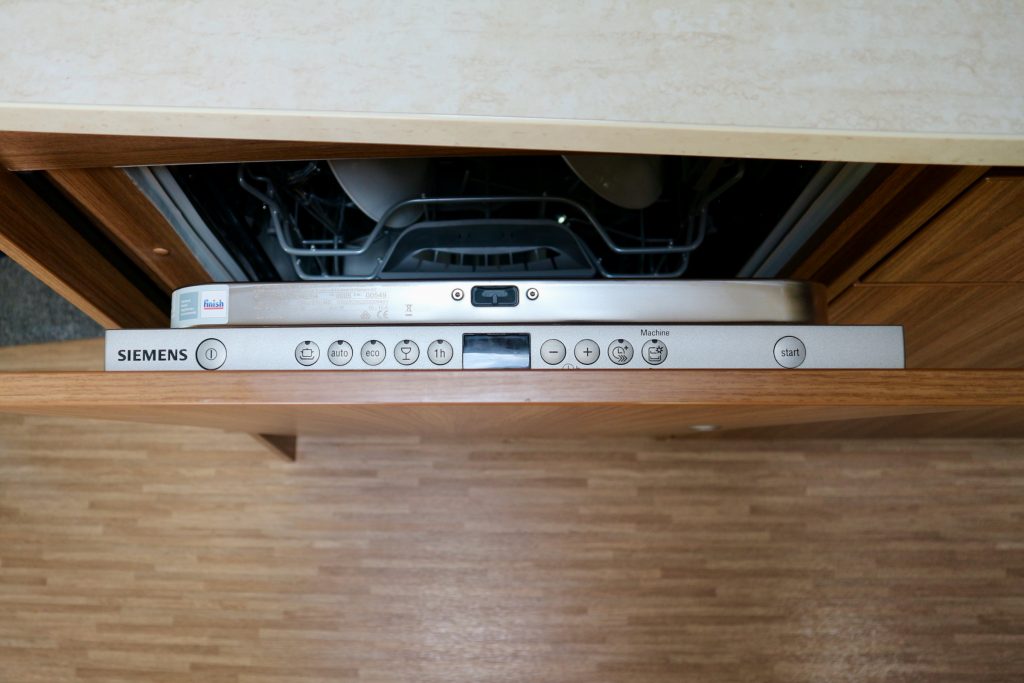
Was the relatively big effort worth it for us?
Absolutely! Since the machine has been working, the dishes disappear from the table in a few minutes after each meal and only reappear when they are clean and dry. The dishwasher is surprisingly quiet and only makes itself noticeable now and then by switching on the water pump, but this doesn’t disturb anyone while they’re sleeping. When the fuse is 6 or 10 A, everything works wonderfully and the water consumption is low. Only with lower fuses do we need to provide hot water and probably use a little more water overall than with a hand wash. Nevertheless, we would not want to do without this little luxury ever again.
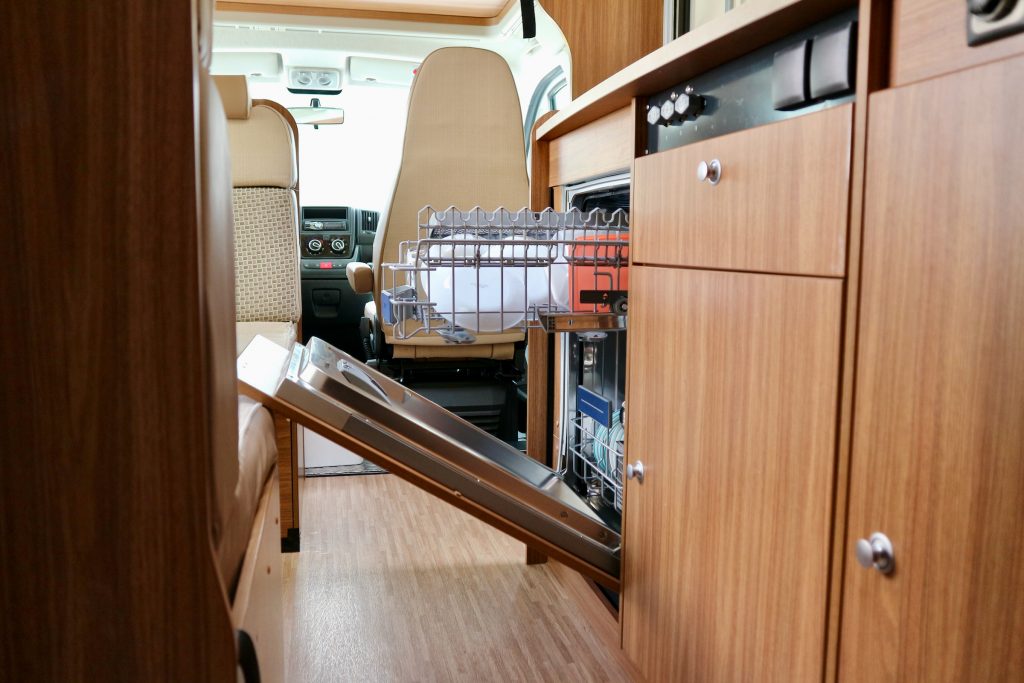
Improvement suggestions
Surely it would have been even better to install a dishwasher with a cold water programme, so that lower fuse ratings would not cause any problems. But such a machine does not seem to exist. Also, I have not found any hints for reducing the power of the heating element of the dishwasher. We will certainly install a voltage transformer with a higher output, but we have heard that this will not work with the batteries used.
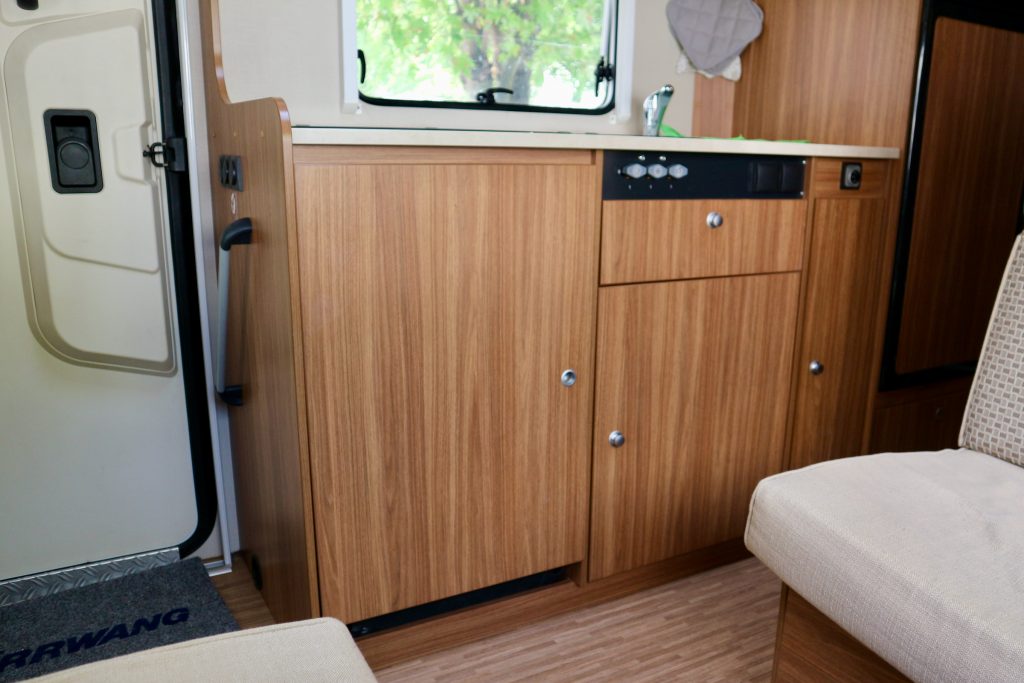
Winter storage
As there are hardly ever temperatures near the freezing point, even during winter in Lisbon, where our camper van is parked, we could ignore the subject of wintering for the time being. However, it would not be too difficult to pump out the water completely and then empty the hoses, the pump pit and the salt compartment. Maybe such a suction pump could be of good use in this case.
Notes: The use of a dishwasher in a motorhome requires some safety measures to be observed during each wash cycle: 1. The water level of the fresh water tank must be at least 10-12 litres of water. We make sure that at least one LED is lit. Otherwise the water pump runs dry and overheats. 2. The waste water tank must still have room for at least 10-12 litres of water, otherwise it may overflow. We make sure that a maximum of three LEDs are lit. 3. If the fuse rating is low (less than 6 A), it is recommended to switch the refrigerator to gas and heat the water to 60 degrees before the rinse cycle. In this case, you should also pump out the water that is already in the machine before the rinse cycle. Depending on the model, there are simple instructions for this in the dishwasher’s user manual. In our model, for example, you start the hottest programme, wait 5 minutes and then stop the programme again.
You will need these components for the reproduction: Note: The following picture links lead to the products we have used ourselves. These are affiliate links for which we receive a small commission if you purchase the products via these links. Dishwasher: Built-in dishwasher with 220 V water stop (Siemens, Bosch should also work) Maximum dimensions for a Carado A 464: H 815 x W 480 x D 550 mm For example:
For the box that redirects the heating air to the heating outlet that is too far forward:
For connection to the sewage system:
You can also do without the pipe piece if you insert the Y-piece in the middle of a longer pipe piece. We have done it this way ourselves.
To activate the water pump:
The connection scheme relay/water pump is available at My Small House
For connection to the hot water tube:
A piece of the hose that is also necessary can be cut out at the point where the hose connector goes.
In addition:
First of all, we have set it up in such a way that we have placed a plug coupling in the right-hand part of the cabinet, so that you can simply plug dishwasher in there. But we can also put a cable from the voltage transformer here and use the power from there if necessary.
Disclaimer: Electrical as well as manual knowledge for the work described above is urgently required. Only an electrician may carry out the electrical work. Coordinate with the electrician of your choice. I am not liable for malfunctions, mistakes and accidents. This article is only intended as an inspiration for the installation of a dishwasher in your own motorhome, not as a construction manual.








